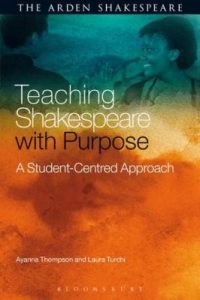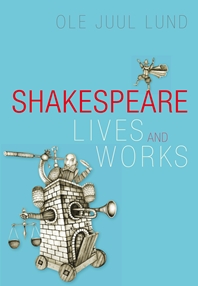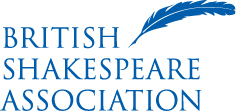This post is part of a series of brief, ‘first impression’ reviews of books on Shakespeare in Education. Look out for others posted to the BSA’s Education Network Blog.
15-minute reviewer: Paul Young
 In a nutshell, this book is about:
In a nutshell, this book is about:
Moving the teaching of Shakespeare away from the traditional teacher-expert led method, which often includes attempts to use the plays as a vehicle to teach a huge range of social/historical/political issues at shallow face value. Instead, it suggests a collaborative student led approach, allowing students to discover their interpretations and every day relevance in Shakespeare for themselves.
Who would like it?
Anybody looking for engaging ways to teach Shakespeare at pretty much every academic level.
Who wouldn’t like it?
People looking for a quick and easy classroom resource guide.
Best feature?
The book contains advice for every part of the teaching process, from idea inception right through to meaningful assessment, meaning it is a very comprehensive guide for how you can rethink planning.
What’s missing?
It is very much a guide aimed at those who are looking to reinvent the way they teach Shakespeare. There’s not that much for people inexperienced in teaching Shakespeare, and it lacks information on the plays if you’re not confident on content.
This post is part of a series of brief, ‘first impression’ reviews of books on Shakespeare in Education. Look out for others posted to the BSA’s Education Network Blog.
15-minute reviewer: BSA Teaching Trustee Chris Green
 In a nutshell, this book is about:
In a nutshell, this book is about:
Introducing Shakespeare, his texts and his contexts, to secondary school students (probably best suited to KS4/5 in the UK). After an opening focusing on the ‘Life and Times’ the book moves on to the dramatic traditions inherited by Shakespeare and then considers the major plays in terms of genre – as well as looking at linguistic techniques and the impact of Shakespeare’s works on the English language and on wider culture. The book has recently been translated from Danish (the author is a teacher and educationalist) and offers an unusual perspective on the ways in which Shakespeare’s works are approached in ‘other’ cultures.
Who would like it?
School students are likely to find this book very accessible and teachers will probably tend to dip into it to provide supporting contextual material for their students. The Danish perspective is likely to provide an interesting angle for Shakespeare scholars. There isn’t a book quite like this available in English (originally) for UK students to use. It plugs an important gap and we could do with other editions – not just translated but also adapted for use in different national school systems.
Who wouldn’t like it?
Readers who dislike any approach to Shakespeare and his plays that attempts to simplify or demystify the subject matter. The approach in the book isn’t exactly a ‘creative’ one – but then again it doesn’t profess to be that.
Best feature?
There’s an admirable clarity to the book. School students looking for a straightforward explanation of exactly why Shakespeare is held up to be the consummate creative genius of western art will find plenty of objective evidence to support that fact here.
What’s missing?
Arguably charmingly old-fashioned at times (depending on your point-of-view) the book makes no attempt – and the author makes no apologies for this – to consider Shakespeare’s plays as scripts for performance and it could therefore be said that the book sidesteps this most important feature of the author’s works.
This post is part of a series of brief, ‘first impression’ reviews of books on Shakespeare in Education. Look out for others posted to the BSA’s Education Network Blog.
Name of reviewing team: Daisy
 In a Nutshell, this book is about:
In a Nutshell, this book is about:
Familiarizing readers with the authors of famous plays, specifically Shakespeare to gain understanding of their reasoning for certain aspects of plays, with specific attention towards their habits, thought process and achievements. Provides lots of knowledge is “how did the plague affect Shakespeare”
Who would like it?
Students, teachers, broad audience is anyone with an inters in Shakespeare and his writing.
Who wouldn’t like it?
People with no interest in Shakespeare and the content he wrote.
Best Features?
- Includes new perspectives and understanding, goes deeper than surface meaning of a text.
- Interesting and intriguing facts that resonate and provoke thought.
Worst Quality?
Could provide more information about certain aspects that haven’t been discussed.
This post is part of a series of brief, ‘first impression’ reviews of books on Shakespeare in Education. Look out for others posted to the BSA’s Education Network Blog.
Name of reviewing team: Katherine
 In a Nutshell, this book is about:
In a Nutshell, this book is about:
- Methods and techniques (Chekhov technique).
- Collaboration between actor and director/teacher
- Rehearsal process.
Who would like it?
- Anyone directing a show
- Teachers
- Actors
- Anyone interested in Michael Chekhov
Who wouldn’t like it?
Directors and actors opposed to Chekhov’s techniques.
Best Feature?
Includes lists of exercises and explains how to do them and their effects on the cast/actor.
Worst Quality?
Focuses a lot on A Midsummer Night’s Dream, could have more options.
This post is part of a series of brief, ‘first impression’ reviews of books on Shakespeare in Education. Look out for others posted to the BSA’s Education Network Blog.
Name of reviewing team: Eve
 In a Nutshell, this book is about:
In a Nutshell, this book is about:
Providing theatre study’s and emerging theatre artists with the tools and skills to analyse scripts. Based around Stanislavsky’s system of acting and method acting. Focus on action, time and places
Who would like it?
Students studying the book mentioned or wanting to expand their understanding of script analysing. Teachers of drama, theatre or English literature
Who wouldn’t like it?
Younger students who are not interested in script analysis. Not necessarily for theatregoers only.
Best Feature?
Includes a range of the most studied pages so most students would have experience or use the book to help with their studies
Worst Quality?
Relatively boring inside. No pictures and lots of text which is not very broken up.
This post is part of a series of brief, ‘first impression’ reviews of books on Shakespeare in Education. Look out for others posted to the BSA’s Education Network Blog.
Name of reviewing team: Kayleigh
 In a Nutshell, this book is about:
In a Nutshell, this book is about:
Exploring different ways to teach Othello to students who are studying. It looks at each scene and gives you lesson plans, character maps.
Who would like it?
Teachers would like this book. Teacher who enjoy teaching more active methods to help engage student’s understanding.
Who wouldn’t like it?
Perhaps the more traditional teacher who prefers sticking to the script without active learning
Best Feature?
The “before reading the scene” summary. This helps the teacher recap what is in the scene. Also the exercise starters.
Worst Quality?
Maybe more pictures in colour, if the teachers wanted to copy/scan a sheet for students.
 In a nutshell, this book is about:
In a nutshell, this book is about:



